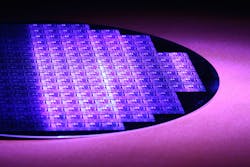Military researchers eye very-large-scale optical integrated circuit manufacturing for photonic computing
Summary points:
- VLPI aims to scale manufacturing of large-format photonic integrated circuits for ultra-efficient, light-based computing.
- Project could revolutionize photonic ICs similar to how VLSI transformed digital electronics in the 1970s.
- DARPA requests feedback on design tools, system applications, and integration challenges by 15 July 2025.
ARLINGTON, Va. – U.S. military researchers are approaching industry for new approaches to manufacturing optical integrated circuits in large-format wafers for a wide variety of power-efficient computing that require little thermal management compared to today's high-performance processors.
Officials of the U.S. Defense Advanced Research Projects Agency (DARPA) in Arlington, Va., has issued a request for information (DARPA-SN-25-88) for the Very Large-scale Photonic Integration (VLPI) project.
Light-based processing can be extremely fast and nearly power dissipation-free, researchers explain. Developing VLPI integrated circuits at scale could unleash entirely new approaches and capabilities. Still, today's research has focused on photonic ICs as replaces for isolated functions like matrix multiplication in otherwise digital electronics.
Work on photonic circuits until now has focused on device performance, not on circuit-enabled functionality, and lacks sufficient circuit design expertise to achieve photonic circuits with millions of components.
Photonic IC capabilities
DARPA is seeking to understand what capabilities might come from advanced photonic integrated circuit technology, today's state of the art, and to determine what remaining technological barriers remain in the design of such circuits.
The VLPI program has the potential to mirror results of a similar DARPA initiative from nearly half a century ago called the Very-Large-Scale Integration (VLSI) program that helped transform defense electronics, semiconductor manufacturing, and advanced computing technologies.
The VLSI program focused on advancing electronic integrated circuit technologies, and played a major role in moving from mainframe to microprocessor-based computing. It enabled flexible development of defense systems involving custom silicon, helped lay the groundwork for rapid growth in computing power, miniaturization, and mobile electronics, and helped to enable the fabless semiconductor model.
Now the VLPI program could do for photonic integrated circuit technology what the VLSI program did for electronic digital circuits by enabling the fabrication of high-performance photonic integrated circuits in large format wafers. Light-based processing can be extremely fast, energy efficient, and lighten the load for thermal management and system cooling.
Software algorithms
From industry, DARPA wants to know that applications that VLPI photonic circuits could enable; the benefits of the VLPI circuits in system performance; how applications could reduce the need for electro-optical transducers; the software algorithms that VLPI integrated circuits could enable; and design approaches that could mimic digital computing using optical computing.
DARPA also wants to hear from industry on today's limitations and new approaches in design automation for VLPI photonic circuits; the state-of the-art in today’s photonics design tools; existing ways to integrate manufacturing variability in photonic circuit designs; limits on the maximum size of the photonic circuit that can be modeled while maintaining physics accuracy; and photonic design algorithms and automation methodologies.
Companies interested should email unclassified responses no later than 15 July 2025 to DARPA at [email protected]. Email questions or concerns to DARPA's Anna Tauke-Pedretti at [email protected]. More information is online at https://sam.gov/opp/0d91f604d4d54bd79881be8b9f9721be/view.
About the Author
John Keller
Editor-in-Chief
John Keller is the Editor-in-Chief, Military & Aerospace Electronics Magazine--provides extensive coverage and analysis of enabling electronics and optoelectronic technologies in military, space and commercial aviation applications. John has been a member of the Military & Aerospace Electronics staff since 1989 and chief editor since 1995.
